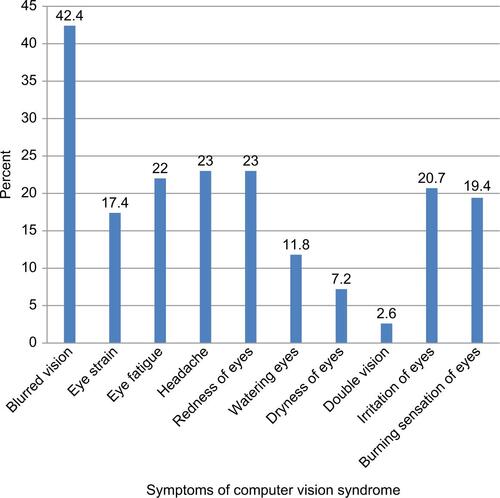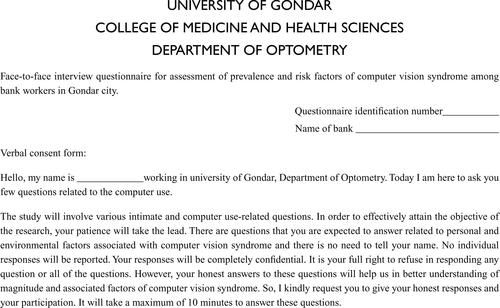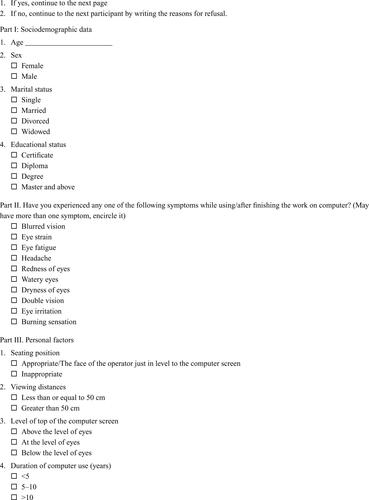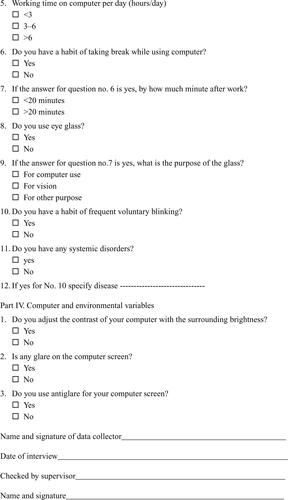Abstract
Introduction
Use of computers is generally encouraged; this is to keep up with the fast-moving world of technology, research and science. Extensive use of computers will result in computer vision syndrome (CVS), and the prevalence is increased dramatically. The main objective of the study was to assess the prevalence and associated factors of CVS among bank workers in Gondar city, northwest Ethiopia.
Methods
A cross-sectional institution-based study was conducted among computer-using bank workers in Gondar city from April to June, 2015. Data were collected through structured questionnaires and observations with checklists, entered with Epi Info™ 7 and analyzed by Statistical Package for the Social Sciences (SPSS) version 20. Descriptive statistics and logistic regression were carried out to compute the different rates, proportion and relevant associations.
Results
Among the total 304 computer-using bank workers, the prevalence of CVS was 73% (95% confidence interval [CI]=68.04, 78.02). Blurred vision (42.4%), headache (23.0%) and redness (23.0%) were the most experienced symptoms. Inappropriate sitting position was 2.3 times (adjusted odds ratio [AOR]=2.33; 95% CI=1.27, 4.28) more likely to be associated with CVS when compared with appropriate sitting position. Those working on the computer for more than 20 minutes without break were nearly 2 times (AOR=1.93; 95% CI=1.11, 3.35) more likely to have suffered from CVS when compared with those taking break within 20 minutes, and those wearing eye glasses were 3 times (AOR=3.19; 95% CI=1.07, 9.51) more likely to suffer from CVS when compared with those not wearing glasses.
Conclusion
About three-fourths of computer-using bank workers suffered from CVS with the most experienced symptoms being blurred vision, headache and redness of eyes. In appropriate sitting position, working on the computer without a break for more than 20 minutes and wearing eye glasses were independently associated with CVS.
Introduction
Globally, personal computers are one of the most common office tools. Using computers had become a 21st century necessity. The use of computers in all institutions, colleges, universities and homes has made life easier and has increased output tremendously.Citation1,Citation2
However, their usage, even for 3 hours/day, has led to a health risk of developing computer vision syndrome (CVS), low-back pain, tension headaches and psychosocial stress.Citation3 Ocular complaints of computer users have been grouped together and collectively termed as CVS.Citation4
The American Optometric Association defines CVS as a complex of eye and vision problems related to the activities that stress the near vision and that are experienced in relation to, or during, the use of the computer. It is characterized by visual symptoms that result from interaction with computer display or its environment.Citation5
CVS is an umbrella term that covers numerous eye- and environment-related conditions that occur when the viewing demands of the task exceed the visual abilities of the user, leading to inability to focus properly on computer images. The eyes cannot remain focused on the pixel-generated images on a computer screen, and as such, the eyes must focus and refocus thousands of times per day while viewing the screen.Citation6
CVS can also be presented with asthenopic symptoms of eyes, such as eye strain, irritation, redness, fatigue, headaches, burning sensation, glare sensitivity, double vision and periodic blurring of near and distant vision.Citation7
Factors contributing to CVS were generally classified as personal factors – poor sitting position, improper viewing distances, improper viewing angle, ocular diseases, medical diseases and aging and environment; and computer factors – poor lighting, imbalance of light between the computer screen and the surrounding, poor resolution, poor contrast, glare of the display and slow refresh rate.Citation8
The discomfort associated with computer usage has not yet been proven to result in permanent damage, but may cause a reduction in work accuracy. This can reduce productivity by as much as 40%.Citation9 Use of computers is generally encouraged; this is to keep up with the fast-moving world of technology, research and science. Researchers have come to an agreement that this could actually be harmful, if not properly managed for future generation.Citation10 Today, in virtually every corporate cubicle and backroom office, on the desks of every bank workers, sits a computer that allows writing, designing, computing and communicating faster than ever before. More time is spent working on a computer; the knowledge of using the computer and the computer screen by itself has a great contribution for the problems related with the use of computers. It is known that CVS is a worldwide problem, but in Ethiopia, there is limited evidence to prove the magnitude and risk of the problem. Accordingly, the study was conducted in Gondar city among bank workers who spent most of their time on computer, to know the magnitude and risk factors of computer-related vision problems. The study conducted in this area will show the magnitude and predictors of CVS, and any technology managers and eye care professionals can use this research for planning of reducing the risk of CVS. Moreover, the study will be a baseline resource for other researchers researching on computer vision-related problems.
Materials and methods
An institution-based cross-sectional study was conducted from May 5 to June 15, 2015 in Gondar city, northwest Ethiopia. Gondar city is located ~750 km northwest from the national capital, Addis Ababa and ~180 km from Bahir Dar city, the regional capital of the Amhara. Gondar is one of the ancient and largely populated cities of the country, having a population of ~303,815. It has a latitude and longitude of 12°36′N and 37°28′E, respectively, with an elevation of 2133 m above sea level.Citation11 In Gondar city, nowadays, there arê33 governmental and nongovernmental banks serving the community. All computer-using bank workers were included in the study except bank workers who had ocular diseases, such as acute, chronic, infective conjunctivitis, any specific eyelid disorders, uncorrected refractive error and other binocular vision problems.
The sample size was determined by using the single population proportion and correction formula because the population was <10,000 (which was 308) with the assumption of the level of significance (α)=5% (with confidence level of 95%), marginal error w=5% and P=0.739 (previous study on secretaries and data processors at Gondar University).Citation12 The Z value was 1.96 (n=sample size, P=proportion and w=marginal error), which was 172 bank workers. But in this study, computer users who were not eligible for the study were excluded, and for the confidence of the research power, all computer-using bank workers (n=308) were the final sample size.
Appropriate sitting position – The face of the operator just in level to the computer screen.Citation13
Bank workers – Professionals who work on government and private banks.
Computer user – Bank workers who use desktop or laptop single-monitor computer devices for their daily work at the bank arena.
Computer vision syndrome – At least one of the asthenopic symptoms of eyestrain, eye fatigue, blurred vision, headache, dry eye, watery eye, blurred vision, double vision, irritation and burning sensation of the eyes that occur as a result of computer use.Citation14
Pretested structured questionnaire (Figure S2) was prepared in English language and translated into Amharic language (working language) for obtaining information about sociodemographic characteristic and personal factors for CVS and then translated back into English language for data entry and analysis. Four data collectors (optometrists) were involved in the data collection procedure. Face-to-face interview using pretested standardized questionnaires and direct observations with checklist was conducted to measure personal and environmental factors by an optometrist. Snellen visual acuity card and pinhole for visual acuity measurement, retinoscope for refraction, torch and magnifying loop for ocular segment examination and viewing distance measurement meter were used for clinical evaluations. There were an optometrist supervisor and principal investigator during data collection. Data were entered using Epi Info™ 7 and exported and analyzed by using Statistical Package for the Social Sciences (SPSS) version 20. Descriptive statistic and logistic regression was carried out to compute the different rates, proportions and relevant associations with 95% confidence interval (CI).
Before conducting the study, ethical clearance was obtained from University of Gondar, College of Medicine and Health Sciences, School of Medicine Ethical Review Committee. Oral consent of each participant was taken after explaining the purpose of the study. Confidentiality of the information was maintained thoroughly by excluding names as identification in the questionnaire and keeping their privacy during data collection, and also individual results were kept secure by locking.
Results
A total of 304 computer-using bank workers were included in the study with a response rate of 98.2%. From the study participants, 198 (65.1%) were men. The mean age of study participants was 28.29 (±4.66) years ().
Table 1 Sociodemographic characteristics of computer-using bank workers in Gondar city, 2015, n=304 (n=sample size)
Seventy-three percent (with 95% CI=68.04, 78.02) of the study participants suffered from CVS.
The symptoms most experienced by the study participants were blurred vision (42.4%), headache (23.0%) and redness (23.0%; Figure S1).
In the bivariate analysis, sitting position (crude odds ratio [COR]=2.56, 95% CI=1.41, 4.65), viewing distance (COR=2.05, 95% CI=1.08, 3.91), the time taking break while using computer (COR=2.05, 95% CI=1.20, 3.49) and using eye glasses (COR=3.17, 95% CI=1.08, 9.27) were significantly associated with CVS ().
Table 2 Bivariate analysis for computer vision syndrome among bank workers in Gondar City, 2015, n=304 (n=sample size)
Multivariate analysis was used to identify characteristics that were independent factors for CVS. By using a forward stepwise selection method, all variables were entered into a multivariate analysis. According to the multivariate analysis, inappropriate sitting position was 2.33 times (adjusted odds ratio [AOR]=2.33, 95% CI=1.27, 4.28) more likely associated with CVS when compared with appropriate sitting position. Working on computer for more than 20 minutes without taking break was significantly (AOR=1.93, 95% CI=1.11, 3.35) associated with CVS when compared with taking break within 20 minutes ().
Table 3 Multivariate analysis for computer vision syndrome among bank workers in Gondar City, 2015, n=304 (n=sample size)
Discussion
This study was aimed to assess the prevalence and identify the associated factors of CVS. From the total of 304 computer-using bank worker study participants, the prevalence of CVS was found to be 73% (95% CI=68.04, 78.02). This is in line with the other studies: 72% in Ajman, United Arab Emirates, among computer worker university students,Citation15 73.9% in São Paulo, Brazil, among computer workersCitation16 and 73.9% in University of Gondar, among secretaries and data processors.Citation12 Evidently, this study result was less than the result reported in Malaysia, which was found to be 89%,Citation17 and in Chennai, which was 80.3%,Citation18 and the reason may be either due to the study participants in these area being university students using computers for a longer time than bank workers or due to students using computers for a long time without eye break for studying rather than most bank workers taking frequent breaks to give services for customers.
Inappropriate sitting position of bank workers was 2.3 times (AOR=2.33, 95% CI=1.27, 4.28) more likely associated with CVS when compared with those having appropriate sitting position. This might be explained by the fact that inappropriate sitting position gives discomfort and stress to the eye, which leads the eye to be more focused and causes the eye muscles more spastic and experience symptoms of CVS; however, in an inappropriate sitting position, bank workers report glare as their major complaint, which they faced during computer use. It can also be justified that eye-and environment-related conditions occur because of inappropriate sitting position, when the viewing demands of the task exceed the visual abilities of the user, leading to inability to focus properly on computer images and experience CVS.Citation8
Those working on computer for more than 20 minutes without break were nearly 2 times (AOR=1.93, 95% CI=1.11, 3.35) more likely to suffer from CVS as compared to those taking break within 20 minutes. This was similar to the study done in the suburban area of Chennai and in Uttar Pradesh, India, in which significant correlation was found between taking less frequent breaks or working on computer for more than 20 minutes without break and being more exposed for symptoms of CVS when compared with taking more frequent breaks within 20 minutes.Citation18,Citation19 These bank workers who had not been taking break within 20 minutes suffered from CVS more significantly, because the eyes normally cannot remain focused on the pixel-generated images on a computer screen for a long time, and as such, the eyes must focus and refocus thousands of times by taking frequent breaks (high refresh rate that the computer screen is repainted to produce an image) within 20 minutes while viewing the screen, and if the refresh rate is too slow it causes a high flickering screen, which leads to suffer from symptoms of CVS.Citation8
Bank workers who wore eye glasses were 3 times (AOR=3.19, 95% CI=1.07, 9.51) more likely exposed for CVS when compared with those not wearing eye glasses. Similar results were reported in Malaysia, where computer users who were wearing spectacles experienced CVS significantly more often than those who were not wearing spectacles.Citation17 Justification for higher prevalence of CVS among eye glass wearers might be that spectacles were not been prescribed by professionals, which resulted in either incorrect prescription or absence of glare or reflection protection surfaces.
Conclusion
About three-fourths of computer-using bank workers suffered from CVS with the most experienced symptoms of blurred vision, headache and redness of eyes. Inappropriate sitting position, working on the computer for more than 20 minutes without taking frequent breaks and wearing eye glasses were the factors independently associated with CVS. To avoid these computer-related vision problems, it is better to give eye health education for computer users on how to use computers, and the symptoms, treatment options and prevention strategies of CVS.
Author contributions
All authors contributed toward data collection, data analysis, drafting and critically revising the paper and agree to be accountable for all aspects of the work.
Acknowledgments
We were grateful to appreciate University of Gondar for the financial support that enabled us to conduct the study. We would also like to give our deepest gratitude to the study participants for their kindness and cooperation to be included in the study.
Supplementary material
Disclosure
The authors report no conflicts of interest in this work.
References
- GriffithsKLMackeyMGAdamsonBJThe impact of a computerized work environment on professional occupational groups and behavioral and physiological risk factors for musculoskeletal symptomsJ Occup Rehabilx2007174743765
- AnshelJVisual Ergonomics HandbookNew York, NYTaylor and Francis2005
- SenARichardsonSA study of computer-related upper limb discomfort and computer vision syndromeJ Hum Ergol (Tokyo)2007362455018572794
- BaliJNavinNThakurBRComputer vision syndrome: a study of the knowledge, attitudes and practices in Indian ophthalmologistsIndian J Ophthalmol200755428929417595478
- Computer vision syndrome (CVS)American Optometric Association [cited April 14, 2012]. Available from: http://www.aoa.org/x5374.xmlAccessed March 11, 2015
- GrandAHThe computer user syndromeJ Am Optom Assoc198758118929013693780
- KozeisNImpact of computer use on children’s visionHippokratia200913423023120011087
- CharpeNAKaushikVComputer vision syndrome (CVS): recognition and control in software professionalsJ Hum Ecol20092816769
- HayesJRSheedyJEStelmackJAHeaneyCAComputer use, symptoms, and quality of lifeOptom Vis Sci200784873874417700327
- NunooMA sight for sore eyes: Computer displays can be hazardous to your visionBlack enterprise19962834445
- YallewWWTerefeMWHerchlineTEAssessment of water, sanitation, and hygiene practice and associated factors among people living with HIV/AIDS home based care services in Gondar city, EthiopiaBMC Public Health201212105723216835
- AlemayehuMNegaATegegneEMuleYPrevalence of self reported computer vision syndrome and associated factors among secretaries and data processorsJ Biol Agric Healthc201441522243208
- HazarikaAKSinghPKUnderlying eye conditions responsible for computer vision syndromeSMU Med J201412132138
- ChiemekeStella CMember, IAENGAkhahowaAllen EOlajireBEvaluation of Vision-Related Problems amongst Computer Users: A Case Study of University of Benin, NigeriaProceedings of the World Congress on Engineering WCE20071London, UK2–4 July 2007
- ShantakumariNEldeebRSreedharanJGopalKComputer use and vision-related problems among university students in ajman, United Arab EmirateAnn Med Health Sci Res20144225826324761249
- SáERochaLThe prevalence of risk factors associated with computer vision syndrome among computer works in São Paulo, BrazilOccup Environ Med201471Suppl 1A103
- ReddySCLowCKLimYPLowLLMardinaFNursalehaMPComputer vision syndrome: a study of knowledge and practices in university studentsNepal J Ophthalmol201351016116824172549
- LogarajMMadhupriyaVHegdeSComputer vision syndrome and associated factors among medical and engineering students in ChennaiAnn Med Health Sci Res20144217918524761234
- AgarwalSGoelDSharmaATo evaluate the factors contributing to Ocular complaints in computer usersJ Clin Diagn Res20137233133523543722




